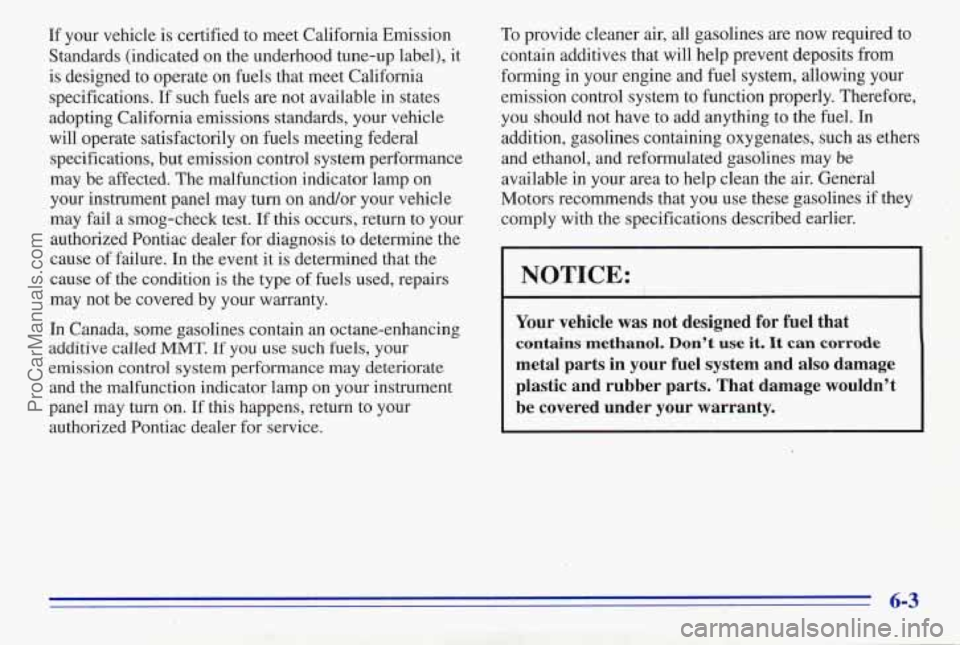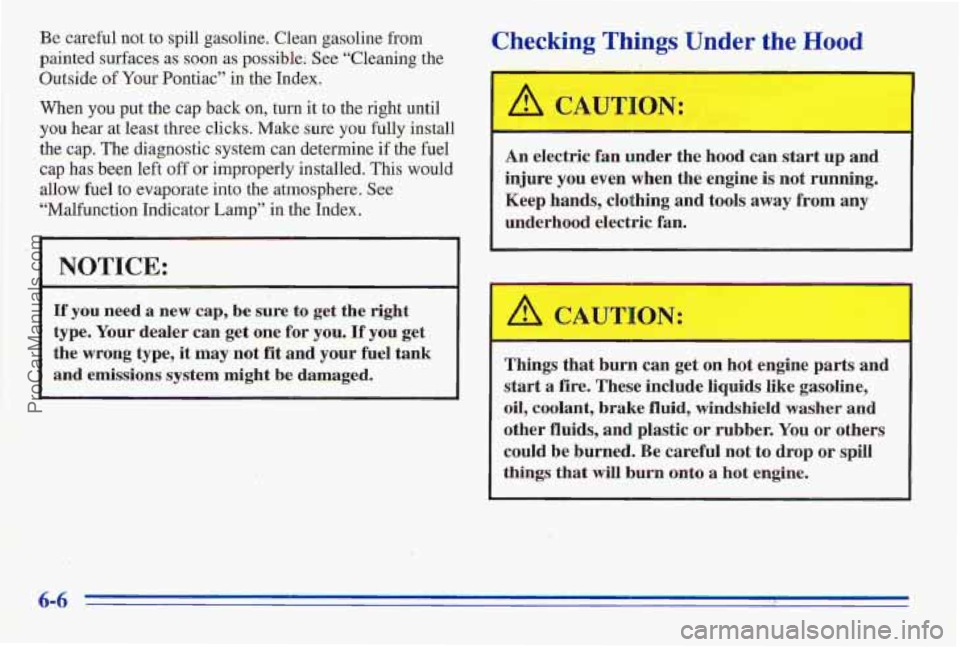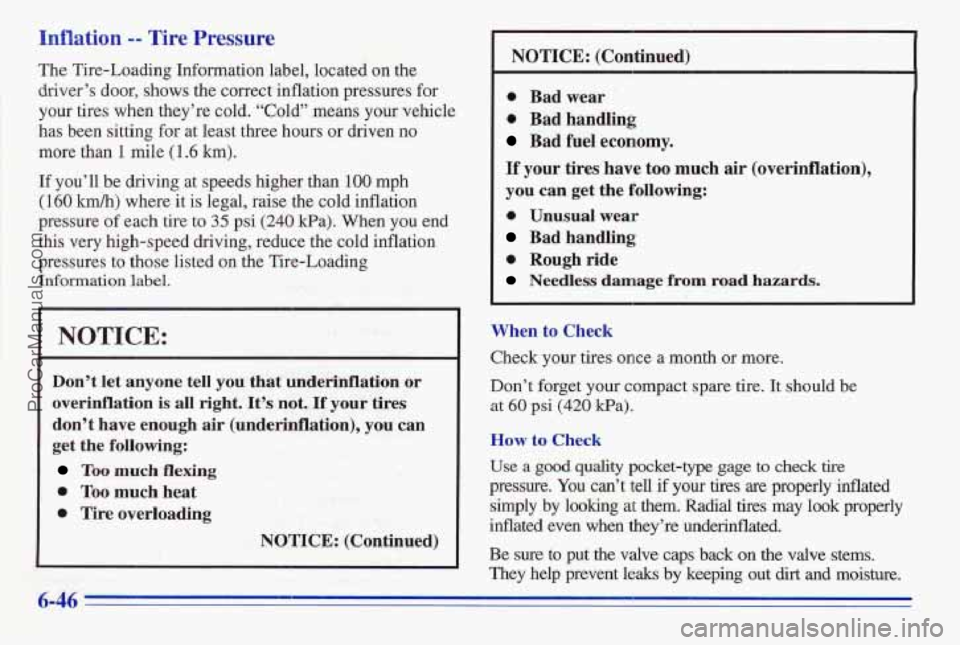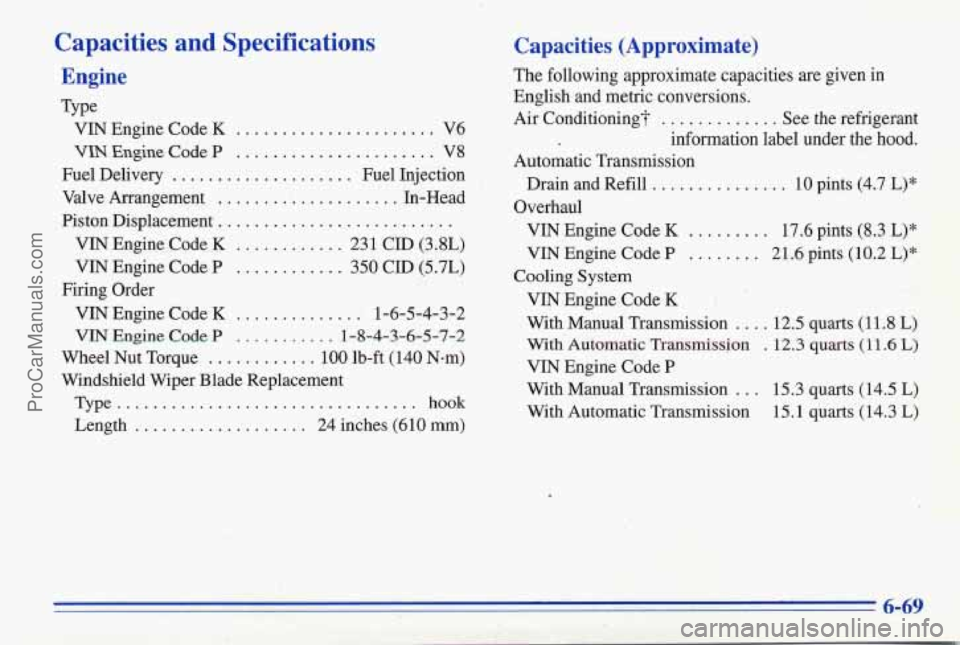fuel type PONTIAC FIREBIRD 1996 Owners Manual
[x] Cancel search | Manufacturer: PONTIAC, Model Year: 1996, Model line: FIREBIRD, Model: PONTIAC FIREBIRD 1996Pages: 386, PDF Size: 19.18 MB
Page 244 of 386

If your vehicle is certified to meet California Emission
Standards (indicated on the underhood tune-up label), it
is designed to operate on fuels that meet California
specifications.
If such fuels are not available in states
adopting California emissions standards, your vehicle
will operate satisfactorily on fuels meeting federal
specifications, but emission control system performance
may be affected. The malfunction indicator lamp
on
your instrument panel may turn on and/or your vehicle
may fail a smog-check test. If this occurs, return to your
authorized Pontiac dealer for diagnosis to determine the
cause of failure. In the event it is determined that the
cause of the condition is the type
of fuels used, repairs
may not be covered by your warranty.
In Canada, some gasolines contain an octane-enhancing
additive called
MMT. If you use such fuels, your
emission control system performance may deteriorate and the malfunction indicator lamp on your instrument
panel may
turn on. If this happens, return to your
authorized Pontiac dealer for service.
To provide cleaner air, all gasolines are now required to
contain additives that will help prevent deposits from
forming in your engine and fuel system, allowing your
emission control system to function properly. Therefme,
you should not have to add anything to
the fuel. In
addition, gasolines containing oxygenates, such as ethers
and ethanol, and reformulated gasolines may
be
available in your area to help clean the air. General
Motors recommends that you use these gasolines
if they
comply with the specifications described earlier.
NOTICE: I
Your vehicle was not designed for fuel that
contains methanol. Don’t use it. It can corrode
metal parts in your fuel system and also damage
plastic and rubber parts. That damage wouldn’t
be covered under your warranty.
6-3
ProCarManuals.com
Page 247 of 386

Be careful not to spill gasoline. Clean gasoline from
painted surfaces as soon as possible! See “Cleaning the
Outside
of Your Pontiac” in the Index.
When
you plat the cap back on, turn it to the right until
you hear at least three clicks. Make sure you fully install
the cap. The diagnostic system can determine if the fuel
cap
has been left of or improperly installed. This would
allow fuel to evaporate into
the atmosphere. See
“Malfunction Indicator
Lamp” in the Index.
NOTICE:
If you need a new cap, be sure to get the right
type. Your dealer can get one for you, If you get
the
wrong type, it may not fit and your fuel tank
and emissions system might
be damaged.
.j
Checking Things Und-- the Hoop
An electric fan under the hood can start up and
injure you even when the engine is not running.
Keep hands, clothing and tools away
from any
underhood electric fan.
Things that burn can get on hot engine
parts and
start a fire. These include liquids like gasoline,
oil,
coolant, brake fluid, windshield washer and
other fluids, and plastic or rubber. You or others
could be burned. Be careful not to drop or spill
things
that will burn onto a hot engine.
6-6 .:
ProCarManuals.com
Page 287 of 386

Inflation -- Tire Pressure
The Tire-Loading Information label, located on the
driver’s door, shows the correct inflation pressures for
your tires when they’re cold. “Cold“ means your vehicle\
has been sitting for
at least three hours or driven no
more than 1 mile ( 1.6 km).
If you’ll be driving at speeds higher than 100 mph
(160 km/h) where it is legal, raise the cold inflation
pressure
of each tire to 35 psi (240 Pa). When you end
this very high-speed driving, reduce the cold inflation
pressures to those listed on the Tire-Loading
Information label.
NOTICE:
~ ~~ ~~ ~
Don’t let anyone tell you that underinflation or
overinflation
is all right. It’s not. If your tires
don’t have enough air (underinflation),
you can
get the following:
Too much flexing
e Too much heat
0 Tire overloading
NOTICE: (Continued)
~ ~~~~
NOTICE: (Continued)
0 Bad wear
0 Bad handling
Bad fuel economy.
If your tires have too much air (overinflation),
you can get the following:
0 Unusual wear
Bad handling
0 Rough ride
Needless damage fram road hazards.
When to Check
Check your tires once a-month or more.
Don’t forget your compact spare tire. It should be
at 61) psi (420 kPa).
How to Check
Use a good quality pocket-type gage to check tire
pressure. You can’t tell if your tires are properly inflated
simply by looking at them.
Radial tires may look properly
inflated even when they’re underidlated.
Be sure to put the valve caps back on the valve stem.
They help prevent
leaks by keeping out dirt and moisture.
ProCarManuals.com
Page 310 of 386

Capacities and Specifications
Engine
Type VIN Engine Code
K ...................... V6
VTN Engine Code P ...................... V8
Fuel Delivery .................... Fuel Injection
Valve Arrangement
.................... In-Head
Piston Displacement
..........................
VINEngine Code K ............ 231 CID (3.8L)
VIN Engine Code
P ............ 350 CID (5.7L)
VIN Engine Code K .............. 1-6-5-4-3-2
VIN Engine Code P ......... 1-8-4-3-6-5-7-2
Wheel Nut Torque ............ 100 lb-ft (140 N-m)
Windshield Wiper Blade Replacement
Type ............ ................. hook
Length ........ ... 24 inches (610 mm)
Firing Order
Capacities (Approximate)
The following approximate capacities are given in
English and metric conversions.
Air Conditioning?
............. See the refrigerant
information label under the hood.
Automatic Transmission
Drain and Refill ............... 10 pints (4.7 L)*
Overhaul
VIN Engine Code
K ......... 17.6 pints (8.3 L)*
VIN Engine Code P ........ 21 ..6 pints (10.2 L)*
VIN Engine Code K V)
With Manual Transmission .... 12.5 quarts (11.8 L)
With' Automatic "ransmissjon . 12.3 qums (1 1.6 L)
VIN Engine Code P
With Manual Transmission ... 15.3 quarts (14.5 L)
With Automatic Transmission 15.1 quarts (14.3
L)
Cooling System
6-69
ProCarManuals.com